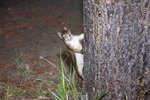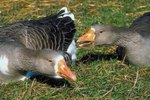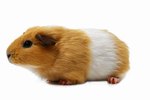
Flying squirrels are found living in various habitats across North America, from the dense forests of Washington to the mountains of North Carolina. These mammals build their nests between 3 and 60 feet above the ground in spruce, fir, beech, maple and mixed hemlocks. Male and female flying squirrels are similar in appearance but vary in their behavior.
Close Inspection
Male and female flying squirrels can be identified by examining their genitals. At about 3 months of age, male flying squirrels are identifiable by their large scrotum. For females, a search through their fur may uncover the vulva, which is open, swollen and pink if they're fertile. Pregnant females may have swollen nipples, which would otherwise be small bumps. For newborns and juveniles around 1 month old, identifying gender can be difficult, as genitals are not fully developed.
Looking in the Mirror
Besides differences in genitals, male and female flying squirrels look alike. These mammals weigh no more than 5 ounces and generally measure between 11 and 14 inches long. Possible colors of flying squirrels' fur include gray, black, dark brown or cinnamon brown with white or gray belly fur. Both males and females have a fleshy membrane known as a patagium, which is covered by fur and extends from their wrists to their ankles. This skin enables flying squirrels to glide from tree to tree at lengths of 100 feet.
Selective Territories
Territories average 1 acre for females, while male territories overlap and average 1.5 acres. Males and females live together in nests. Female flying squirrels are territorial, especially during mating season. Males are not territorial and often outnumber females in a territory. If threatened, females will lunge at intruders and stamp their feet. Females also slap or chase intruders to defend their territories.
Bundle of Babies
Both male and female flying squirrels reach sexual maturity at 1 year old. From March to May or from June to August, a female pairs up with a male to mate. Although monogamous during this time, they do not always pair up with the same mate year after year. After a gestation period of 40 days, females give birth to three to six offspring. Southern flying squirrels mate twice per year, while northern flying squirrels mate only once per year in early spring.
Mother Knows Best
Mother flying squirrels are very protective of their young. Males take no part in caring for offspring and are not permitted near occupied nests. Mothers feed newborns with milk, but eventually switch over to insects, berries and soft twigs as the baby flying squirrels grow up. Young flying squirrels are independent after four months. Flying squirrels have an average lifespan of four or five years.
References
- University of Michigan BioKids: Northern Flying Squirrel
- University of Wisconsin-Stevens Point: Northern Flying Squirrel
- Northern State University: Northern Flying Squirrel
- State University of New York College: Southern Flying Squirrel
- University of Michigan BioKids: Southern Flying Squirrel
- United States Department of Agriculture: Maturation and Reproduction of Northern Flying Squirrels in Pacific Northwest Forests
- National Flying Squirrel Association: Sexing Flyers
Photo Credits
-
Jupiterimages/Photos.com/Getty Images
Writer Bio
Amanda Williams has been writing since 2009 on various writing websites and blogging since 2003. She enjoys writing about health, medicine, education and home and garden topics. Williams earned a Bachelor of Science in biology at East Stroudsburg University in May 2013. Williams is also a certified emergency medical technician.




